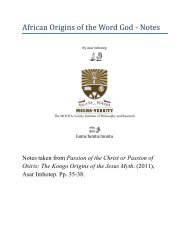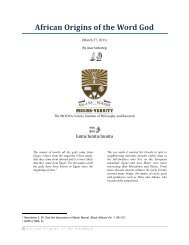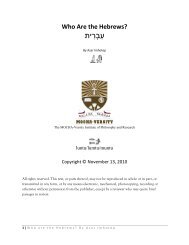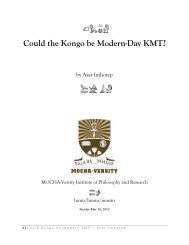reinterpretations of the ankh symbol part 2 - Asar Imhotep
reinterpretations of the ankh symbol part 2 - Asar Imhotep
reinterpretations of the ankh symbol part 2 - Asar Imhotep
You also want an ePaper? Increase the reach of your titles
YUMPU automatically turns print PDFs into web optimized ePapers that Google loves.
6<br />
Many Egyptologists understood that <strong>the</strong> anx was associated with <strong>the</strong> breath but now we know why.<br />
The primary function <strong>of</strong> <strong>the</strong> thorax is respiration (breathing). The ribs (spr) and <strong>the</strong> diaphragm<br />
(ntnt) 4 move so that <strong>the</strong> thoracic cavity increases and decreases in size during <strong>the</strong> inspiratory and<br />
expiratory phases <strong>of</strong> respiration. Doctors note that <strong>the</strong> thorax probably aids in returning venous<br />
blood back to <strong>the</strong> heart because <strong>of</strong> <strong>the</strong> negative pressure produced with respiratory movements.<br />
This is going to be vitally important for our second interpretation <strong>of</strong> <strong>the</strong> anx <strong>symbol</strong> later on in our<br />
discussion. The thorax also serves to protect <strong>the</strong> organs located within its cavity plus some organs<br />
<strong>of</strong> <strong>the</strong> abdominal cavity. In o<strong>the</strong>r words, <strong>the</strong> thorax is our internal savior (a savior is someone or<br />
something that protects).<br />
THE STRUCTURE OF THE THORAX<br />
The primary organs and structure <strong>of</strong> <strong>the</strong> thorax consist <strong>of</strong> <strong>the</strong> following:<br />
� lungs (smA)<br />
� heart (ib, HAty)<br />
� aorta and its branches<br />
� superior and inferior vena cavae<br />
� trachea (xx)and primary bronchi<br />
� sympa<strong>the</strong>tic trunks and <strong>the</strong>ir associations<br />
� azygos and hemiazygos venous systems<br />
The bony boundaries <strong>of</strong> <strong>the</strong> thorax consist <strong>of</strong>:<br />
� sternum<br />
o manubrium (1)<br />
o sternal angle (2)<br />
o body (3)<br />
o xiphoid process (4)<br />
� 12 pairs <strong>of</strong> ribs<br />
o 6 or 7 pairs <strong>of</strong> true ribs (5)<br />
o 3 or 4 pairs <strong>of</strong> false ribs (6)<br />
o 2 pairs <strong>of</strong> floating ribs (7)<br />
� thoracic inlet (superiorly) (8)<br />
� thoracic outlet (inferiorly) (9)<br />
� thoracic vertebrae, posteriorly<br />
4 Apparently <strong>the</strong> Egyptians knew <strong>the</strong> diaphragm was connected to breathing as <strong>the</strong> word nti “breath, air” is<br />
related to ntnt “diaphragm.”






